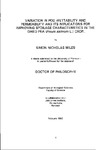VARIATION IN POD WETTABILITY AND PERMEABILITY AND ITS IMPLICATIONS FOR IMPROVING SPOILAGE CHARACTERISTICS IN THE DRIED PEA (Pisum sativum L.) CROP
| dc.contributor.author | MILES, SIMON NICHOLAS | |
| dc.contributor.other | School of Biological and Marine Sciences | en_US |
| dc.date.accessioned | 2013-11-18T13:07:00Z | |
| dc.date.available | 2013-11-18T13:07:00Z | |
| dc.date.issued | 1993 | |
| dc.identifier | NOT AVAILABLE | en_US |
| dc.identifier.uri | http://hdl.handle.net/10026.1/2727 | |
| dc.description.abstract |
This investigation was designed to determine some of the causes of spoilage in the pea crop. It was found that physiological and morphological characteristics of the pods were related to degrees of spoilage experienced by a range of varieties. This included the amount and configuration of epicuticular waxes affecting pod surface wettabilities which, together with total pod wall and parchment layer thicknesses, all contributed to high rates of water uptake and water contents in pod tissues. Water content was determined to be closely correlated to the degree of pod spoilage observed in the field. Pod phenotypes which were badly affected included waxless and parchmentless varieties which were unable to resist the uptake of water, and thick walled pods which retained water for longer periods. Thin walled varieties and those with neoplasms were more successful, not because they resisted water uptake, but because they were able to dispel it rapidly so reducing the length of wetness periods. The most detrimental environments for pod development were those with fluctuating parameters, particularly temperature. This caused the disruption of epicuticular wax conformation increasing surface wettability. It may also have had the effect of decreasing pod wall integrity. Humidity had much less of an independent effect but combined with certain temperatures it became more significant. High temperature/low humidity environments caused high water potential gradients from pod to atmosphere and possible tissue damage leading to high spoilage potential. High temperature/high humidity lengthened periods of water retention in the pods. Yield and spoilage of leafless and parchmentless phenotypes were most sensitive to environment. Pod characteristics determined to be advantageous in this investigation could be incorporated into a wider breeding strategy which includes the improvement of standing ability and root formation so that peas become a more attractive alternative source of protein. | en_US |
| dc.description.sponsorship | John lnnes Institute, Colney lane, Norwich | en_US |
| dc.language.iso | en | en_US |
| dc.publisher | University of Plymouth | en_US |
| dc.title | VARIATION IN POD WETTABILITY AND PERMEABILITY AND ITS IMPLICATIONS FOR IMPROVING SPOILAGE CHARACTERISTICS IN THE DRIED PEA (Pisum sativum L.) CROP | en_US |
| dc.type | Thesis | |
| plymouth.version | Full version | en_US |
| dc.identifier.doi | http://dx.doi.org/10.24382/1512 | |
| dc.identifier.doi | http://dx.doi.org/10.24382/1512 |
Files in this item
This item appears in the following Collection(s)
-
01 Research Theses Main Collection
Research Theses Main


